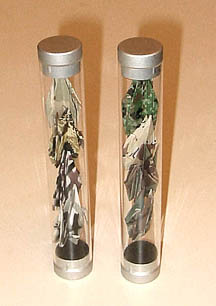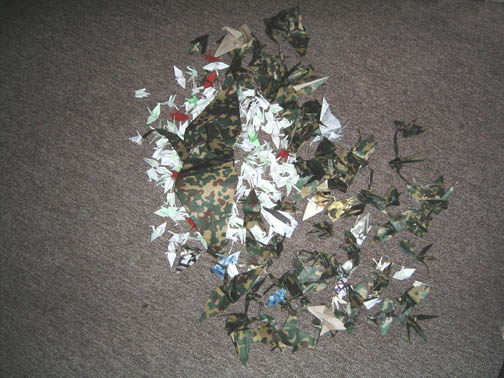AFTER HIROSHIMA : Nuclear Imaginaries
Curated by Siumee Keelan
Operation Peace Crane is proud to participate in a gallery commemorating the 60th year of the atomic bomb.
Opening at the Brunei Gallery, School of Oriental and African Studies - July 11 to September 24, 2005
Then tour to the Millais Gallery, Southampton Institute - January to March 2006
http://www.afterhiroshima.org/


above: camo crane for after hiroshima exhibition (case: Monster)
below: camo crane from uplink, tokyo sent to London (photo: Top Bill)

Origami
Cranes required for the After Hiroshima exhibition!
Part of the exhibition will include a display of origami cranes in memory
of Sadako Sasaki and victims of Hiroshima. To achieve this we require
as many cranes as possible.
All contributions of cranes are welcome and all contributors will be acknowledged
within the exhibition. The Cranes collected will be displayed and will
be sent to Hiroshima after the exhibition tour!
A preferred format would be from 15 cm (about 6 inches) origami paper.
(Of course, any paper or pattern is OK!)
Please send your origami cranes along with:
your name and address to allow acknowledgement to;
Copad Arts After Hiroshima
31, Hertford Avenue
East Sheen, London.
SW14 8EF
United Kingdom
The closing date for contributions is June 30 2005.
However for work to be acknowledged in the exhibition catalogue,
it should be received by the March 31st 2005.
(sorry for short notice!)
For more details see http://www.afterhiroshima.org/exhibition.htm
Link: British
Origami Society amazing skills!
If you are
sending in camo cranes, please send us a picture also!
email
1000 Cranes,
Sadako Sasaki, and Hiroshima
(taken from afterhiroshima.org)
At the age of twelve, a Japanese girl living in Hiroshima, Sadako Sasaki
fell ill from Leukemia. Sadako had been a baby when the bomb had dropped
but lived within two kilometres of where the bomb exploded. The disease
was attributed to the side effects of the atomic bomb. A visitor to
her in Hospital told Sadako of a legend. She told her that if a sick
person folded 1,000 paper cranes they would soon get well. The crane
was a sacred bird in Japan that lives for a hundred years. Determined
to beat her illness Sadako set about folding 1,000 cranes. She kept
folding throughout her illness but sadly died before completing the
task. She had managed to make 644 paper cranes.
Word of Sadako's efforts spread quickly throughout Japan and overseas,
and money was collected to build a monument to her memory. On May 5,
1958, almost 3 years after Sadako died, a monument to her was constructed
close to the centre of the Hiroshima Peace Park. It is now known as
the Children's Peace Monument. People from all over the world continue
to send folded paper cranes in memory of Sadako Sasaki. On August 6,
world peace day, a ceremony is held in her memory where the cranes are
placed on the monument. Folding 1,000 cranes continues to be associated
with Hiroshima and other peace movements who use origami cranes as a
method of showing their commitment to world peace.